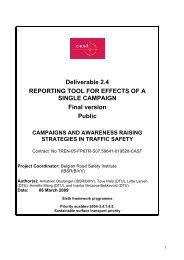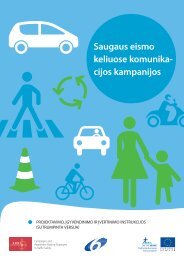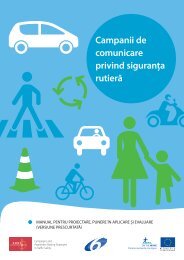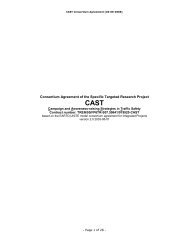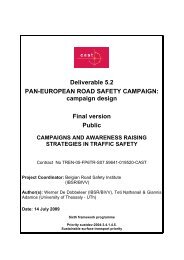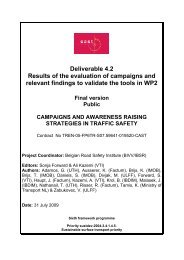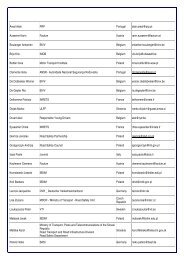Deliverable D 1.3 RESULTS OF META-ANALYSIS ... - cast-eu.org
Deliverable D 1.3 RESULTS OF META-ANALYSIS ... - cast-eu.org
Deliverable D 1.3 RESULTS OF META-ANALYSIS ... - cast-eu.org
Create successful ePaper yourself
Turn your PDF publications into a flip-book with our unique Google optimized e-Paper software.
Campaigns and awareness raising strategies in traffic safety — <strong>Deliverable</strong> D-1.17.5.6 SUMMARYThe overall effects of road safety campaigns on either accidents or seatbeltuse have been presented according to variables describing the background,delivery or content of the campaigns, to get an idea about the size of effectsthat campaigns sharing a certain property have. It should be remembered thateach of these campaigns will also vary according to a number of other factorsnot controlled for in the bivariate analysis presented in this section.Throughout subgroup analyses we have seen some consistencies betweenaccident and seatbelt effects. There is some evidence according to bothmeasures that campaign effects improve where a campaign:- identifies a target group;- uses personal communication;- combines emotional and rational content in its appeal; or- addresses the social norm.According to both measures we found no evidence of a link betweencampaign effect and- campaign scale;- accompanying enforcement; or- humour (not assessed for accident counts)However, inconsistencies are also apparent. Some, such as the link betweenvalue of the pre-campaign measure and campaign effect, can be easilyexplained. Others are less obvious. For instance, it is not as clear whyseatbelt use and not accident counts would be better after a road safetycampaign rather than during a campaign or why the data suggests thatseatbelt use rates but not accident counts are better for those campaignsusing target group consultation. There are several possible explanationshowever.One is that most accident effects are from campaigns whose themes are mostoften not seatbelt use, but drink-driving and speeding. Those aspects ofcampaigns that are more effective at increasing seatbelt use are notnecessarily equally effective at influencing speeding and drink-drivingbehaviours.Another explanation is that the effectiveness of different campaign factorsmight also vary according to scale or other complicating factors. If, forexample, substantially more seatbelt use effects than accident effects arelinked to small scale campaigns, and those factors making small-scalecampaigns effective are different from those making large-scale campaignseffective, then we will have apparent discrepancies among accident andseatbelt trends.Multi-variate analysis (meta-regression) should help clarify suchdiscrepancies, and pick out which of the apparently beneficial factors listedabove remain important when other factors are controlled for.88



